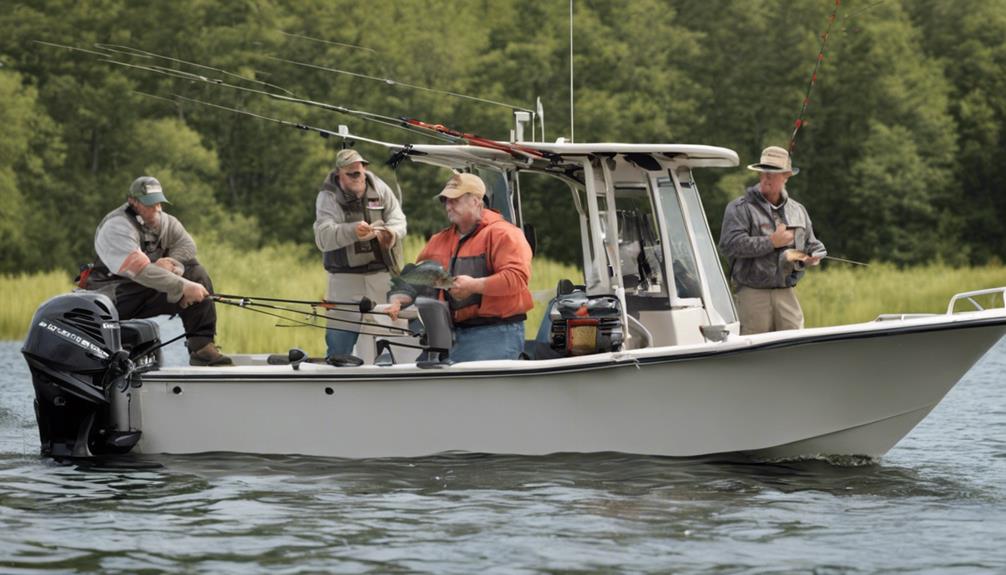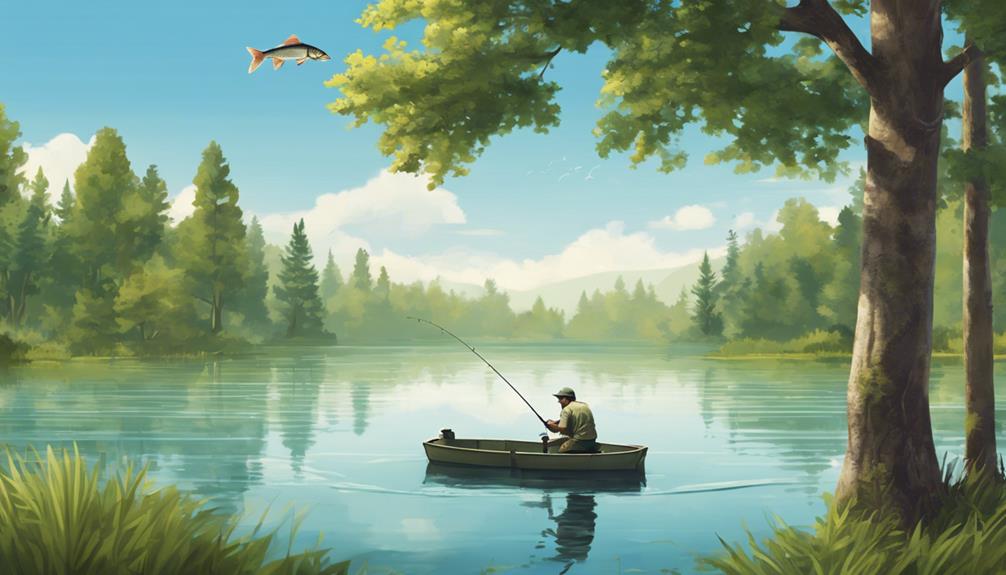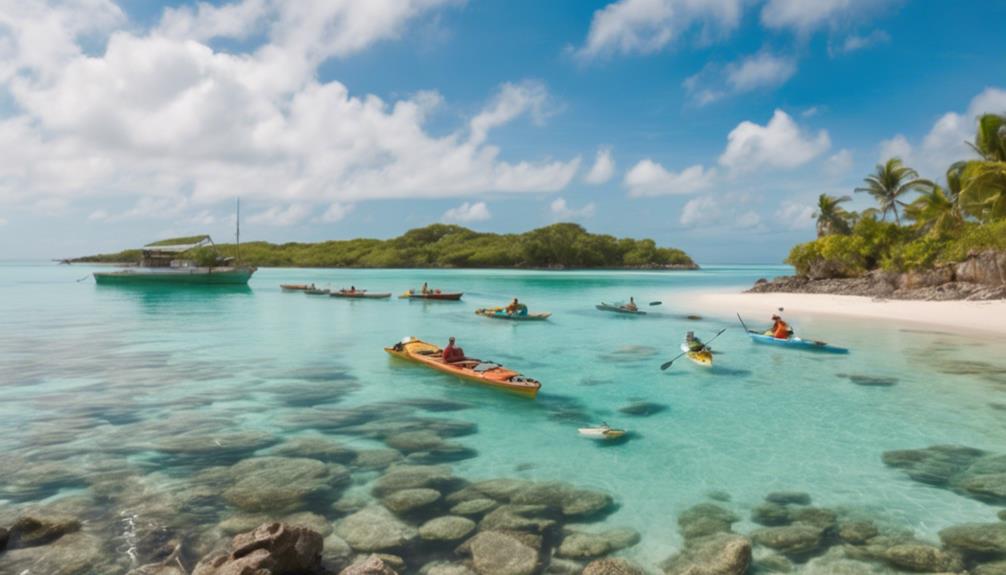Have you ever wondered how sustainable fishing habitats can truly be achieved?
By focusing on three key strategies, you can make a significant impact on the health of our oceans and marine life. These strategies are essential for ensuring the long-term viability of our fisheries and the well-being of coastal communities that rely on them.
By exploring innovative approaches to conservation and management, we can pave the way for a more sustainable future for our oceans.
Importance of Eco-Friendly Practices
By prioritizing eco-friendly practices in fishing, you can directly contribute to the sustainability of marine habitats. Conservation initiatives play a crucial role in ensuring the long-term health of our oceans. By implementing sustainable practices such as using selective fishing gear, respecting catch limits, and reducing bycatch, you can help preserve marine ecosystems for future generations.
Conservation initiatives focus on protecting vulnerable species, reducing overfishing, and minimizing the impact of fishing activities on the environment. By supporting these efforts, you actively participate in safeguarding the delicate balance of marine life. Sustainable practices not only benefit the ecosystem but also ensure the viability of the fishing industry in the long run. By adopting responsible fishing methods, you help maintain fish populations at healthy levels, supporting both the environment and the livelihoods of fishermen.
When you choose to follow eco-friendly practices, you become an advocate for the oceans. Your actions can inspire others to prioritize sustainability and conservation. By spreading awareness about the importance of protecting marine habitats, you contribute to a collective effort to preserve the biodiversity of our oceans. Through your individual choices, you can make a significant impact on the health and resilience of marine ecosystems.
Enhancing Marine Biodiversity
To promote the flourishing of marine biodiversity, actively engage in habitat restoration efforts along coastlines and in key marine ecosystems. Marine conservation relies heavily on maintaining diverse habitats that support a wide range of marine species. By focusing on habitat restoration, you contribute significantly to the preservation of marine biodiversity.
Participating in habitat restoration projects not only aids in the protection of endangered species but also enhances the overall health of marine ecosystems. These efforts help recreate natural habitats that may have been damaged due to human activities or natural disasters. By supporting habitat restoration initiatives, you play a crucial role in ensuring the long-term sustainability of marine ecosystems.
Habitat restoration is a fundamental aspect of marine conservation, as it provides a foundation for the recovery and protection of diverse marine species. By actively engaging in habitat restoration activities, you actively contribute to the preservation of marine biodiversity. These efforts are essential for creating resilient ecosystems that can adapt to environmental changes and thrive in the face of challenges.
Minimizing Overfishing Impact
Minimizing the impact of overfishing requires implementing sustainable fishing practices to ensure the long-term health of marine ecosystems. To achieve this, consider the following strategies:
- Setting catch limits: Establishing and enforcing catch limits helps prevent the depletion of fish populations. By monitoring and regulating the amount of fish that can be caught, sustainable practices are promoted, allowing fish stocks to replenish.
- Protecting vulnerable species: Conservation efforts should focus on protecting vulnerable species from overfishing. Implementing measures such as seasonal closures or creating marine protected areas can help safeguard species at risk and maintain ecosystem balance.
- Promoting selective fishing gear: Encouraging the use of selective fishing gear, such as hooks and lines instead of nets that can catch non-target species, reduces bycatch and minimizes the impact on marine biodiversity. This approach supports sustainable practices by targeting specific species responsibly.
- Educating and involving stakeholders: Raising awareness among fishermen, consumers, and policymakers about the importance of sustainable fishing practices is crucial. Engaging stakeholders in conservation efforts through education and collaboration fosters a collective responsibility towards preserving marine ecosystems for future generations.
Implementing Marine Protected Areas
Implementing Marine Protected Areas involves establishing designated zones in bodies of water to safeguard marine habitats and species from harmful activities. These protected areas play a crucial role in wildlife conservation by providing safe havens for marine species to thrive without the threat of overexploitation. By restricting fishing, mining, and other destructive practices, Marine Protected Areas help maintain biodiversity and ensure the long-term health of marine ecosystems.
In addition to wildlife conservation, Marine Protected Areas also support habitat restoration efforts. By reducing human interference in these designated zones, natural processes can take place, allowing habitats to recover and flourish. This restoration is essential for the overall health of the marine environment, as it enables ecosystems to regain their balance and resilience.
Furthermore, Marine Protected Areas serve as living laboratories for scientists and researchers to study marine life and ecosystem dynamics. These areas provide valuable insights into the effects of human activities on marine habitats and help inform sustainable management practices.
Promoting Sustainable Aquaculture
In promoting sustainable aquaculture, it's essential to prioritize environmental stewardship and responsible resource management. By implementing innovative aquaculture practices and fostering community partnerships, you can contribute to the conservation of marine ecosystems while supporting the livelihoods of those involved in the industry.
Here are four key strategies to promote sustainable aquaculture:
- Embrace Aquaculture Innovation: Explore and adopt cutting-edge technologies and practices that enhance production efficiency, reduce environmental impact, and ensure the long-term sustainability of aquaculture operations.
- Foster Community Partnerships: Collaborate with local communities, governments, and industry stakeholders to create a shared vision for sustainable aquaculture development. By working together, you can address common challenges and achieve mutually beneficial outcomes.
- Implement Sustainable Fishing Techniques: Integrate best practices for responsible fish farming, such as proper waste management, habitat protection, and disease prevention. These techniques not only safeguard the environment but also enhance the quality and safety of the seafood produced.
- Realize Economic Benefits: Recognize that sustainable aquaculture practices can lead to economic prosperity by ensuring the availability of fish stocks for future generations, maintaining market competitiveness, and securing livelihoods within coastal communities. By balancing environmental concerns with economic interests, you can create a thriving and sustainable aquaculture sector.
Balancing Commercial and Recreational Fishing
To strike a balance between commercial and recreational fishing, consider the impact on marine ecosystems and the sustainability of fish populations. Conservation measures play a crucial role in maintaining this delicate equilibrium. By implementing regulations such as catch limits, size restrictions, and protected areas, both commercial and recreational fishing can coexist while safeguarding the health of marine habitats and ensuring the long-term viability of fish stocks.
When balancing commercial and recreational fishing, it's essential to recognize the economic impact on coastal communities and industries. Commercial fishing provides livelihoods for many, contributing to local economies and global seafood markets. Simultaneously, recreational fishing supports tourism, tackle shops, charter services, and more, boosting revenue in coastal regions. Finding a harmonious relationship between these sectors is key to sustaining both economic prosperity and healthy marine environments.
Monitoring and Enforcing Regulations

Keep a close eye on regulations to ensure compliance and protect marine ecosystems. Monitoring and enforcing fishing regulations is crucial for maintaining sustainable fishing habitats. By utilizing technology solutions and fostering community involvement, we can effectively safeguard the health of our oceans.
Here are four key strategies for monitoring and enforcing regulations:
- Implementing Electronic Monitoring Systems: Utilize technology solutions such as satellite tracking and onboard cameras to monitor fishing activities in real-time. This helps authorities detect any illegal or unsustainable practices promptly.
- Enforcing Strict Penalties: Ensure that regulations are enforced consistently and that violators face significant penalties. This acts as a deterrent and sends a clear message that non-compliance won't be tolerated.
- Engaging Local Communities: Foster community involvement in monitoring fishing activities. Local communities are often the first to notice any irregularities and can play a vital role in reporting violations.
- Regular Audits and Inspections: Conduct regular audits and inspections of fishing vessels to ensure compliance with regulations. By keeping a close check on operations, authorities can address any issues before they escalate.
Engaging Local Communities
Utilize community involvement to enhance monitoring of fishing activities and safeguard marine ecosystems. Engaging local communities is vital for the sustainability of fishing habitats. By promoting community involvement in monitoring fishing practices, you can create a sense of ownership and responsibility among local residents towards protecting marine ecosystems.
Education outreach plays a crucial role in engaging local communities. By providing educational programs and workshops, you can raise awareness about sustainable fishing practices and the importance of preserving marine biodiversity. Encouraging local schools to include marine conservation in their curriculum can also help instill a sense of environmental stewardship from a young age.
Involving local communities in monitoring fishing activities can lead to more effective enforcement of regulations. By establishing community-based monitoring programs, you can gather valuable data on fishing practices and identify any unsustainable activities. This collaborative approach not only helps in safeguarding marine ecosystems but also fosters a sense of partnership between authorities and local residents.
Frequently Asked Questions
How Can Sustainable Fishing Habitats Help Protect Endangered Species?
Sustainable fishing habitats play a crucial role in protecting endangered species. By promoting marine conservation practices, such as reducing bycatch and protecting critical habitats, these habitats help safeguard vulnerable species.
Additionally, through community engagement initiatives, local communities are involved in conservation efforts, fostering a sense of responsibility and stewardship. This collaborative approach not only benefits endangered species but also contributes to ecological restoration and provides economic benefits for the communities involved.
What Role Do Climate Change and Ocean Acidification Play in Affecting Fishing Habitats?
Climate change and ocean acidification have a significant impact on fishing habitats. Rising sea temperatures disrupt ecosystems, affecting fish populations and migration patterns.
Ocean acidification harms marine life, reducing food sources for fish. Overfishing exacerbates these issues, leading to further depletion of fish stocks.
To ensure sustainable fishing habitats, it's crucial to address climate change, combat overfishing, and protect marine environments.
How Do Traditional Fishing Practices Impact Sustainable Fishing Habitats?
Traditional fishing practices can have a significant impact on sustainable fishing habitats. Overfishing and destructive techniques can disrupt ecosystem balance, leading to declines in fish populations and overall habitat health.
It's crucial to promote responsible fishing methods that consider the long-term health of marine ecosystems. By adopting sustainable practices, such as implementing catch limits and using selective gear, you can help preserve fishing habitats for future generations.
What Technologies Are Being Used to Promote Sustainable Fishing Practices?
To promote sustainable fishing practices, new green technologies like aquaculture innovations are being utilized. Remote monitoring and smart sensors play key roles in ensuring responsible fishing practices.
These technologies help track fish populations, monitor water quality, and prevent overfishing. By leveraging these advancements, fishermen can make informed decisions to protect marine ecosystems and promote long-term sustainability in their fishing practices.
How Do International Policies and Agreements Affect the Conservation of Fishing Habitats?
When it comes to international policies and agreements, you play a crucial role in the conservation of fishing habitats. Your support of international cooperation directly impacts the preservation of these vital ecosystems.
By evaluating policy effectiveness and ensuring habitat preservation, you contribute to the sustainability of our oceans.
Your actions can make a significant difference in protecting marine environments for future generations.
Conclusion
In conclusion, implementing eco-friendly practices, enhancing marine biodiversity, and minimizing overfishing impact are crucial strategies for sustainable fishing habitats.
By promoting sustainable aquaculture, balancing commercial and recreational fishing, and enforcing regulations, we can ensure the long-term health of our oceans.
It's important to engage local communities in these efforts to protect our marine ecosystems for future generations.
Together, we can make a positive impact on the health of our oceans and the sustainability of our fisheries.



